
![]() WARNING
WARNING
ELECTRIC SHOCK can kill.
Have an electrician install and service this equipment. Turn the input power OFF at the fuse box before work- ing on equipment. Do not touch electrically hot parts.
_______________________________
CAUTION: Sometimes machine failures appear to be due to PC board failures. These problems can sometimes be traced to poor electrical connections. To avoid problems when troubleshooting and replacing PC boards, please use the following procedure:
1.Determine to the best of your technical abil- ity that the PC board is the most likely com- ponent causing the failure symptom.
2.Check for loose connections at the PC board to assure that the PC board is proper- ly connected.
3.If the problem persists, replace the suspect PC board using standard practices to avoid static electrical damage and electrical shock. Read the warning inside the static resistant bag and perform the following pro-
cedures:
P.C. Board can be dam- aged by static electricity.
- Remove your body’s static charge before opening the
- If you don’t have a wrist strap, touch an unpainted, grounded, part of the equip-
ment frame. Keep touching the frame to pre- vent static
-Tools which come in contact with the P.C. Board must be either conductive,
- Remove the P.C. Board from the static- shielding bag and place it directly into the equipment. Don’t set the P.C. Board on or near paper, plastic or cloth which could have a static charge. If the P.C. Board can’t be installed immediately, put it back in the static- shielding bag.
-If the P.C. Board uses protective shorting jumpers, don’t remove them until installation is complete.
-If you return a P.C. Board to The Lincoln Electric Company for credit, it must be in the
4.Test the machine to determine if the failure symptom has been corrected by the replacement PC board.
NOTE: It is desirable to have a spare (known good) PC board available for PC board trou- bleshooting.
NOTE: Allow the machine to heat up so that all electrical components can reach their oper- ating temperature.
5.Remove the replacement PC board and substitute it with the original PC board to recreate the original problem.
a.If the original problem does not reappear by substituting the original board, then the PC board was not the problem. Continue to look for bad connections in the control wiring harness, junction blocks, and terminal strips.
b.If the original problem is recreated by the substitution of the original board, then the PC board was the problem. Reinstall the replacement PC board and test the machine.
6.Always indicate that this procedure was fol- lowed when warranty reports are to be sub- mitted.
NOTE: Following this procedure and writing on the warranty report, “INSTALLED AND SWITCHED PC BOARDS TO VERIFY PROB- LEM,” will help avoid denial of legitimate PC board warranty claims.
